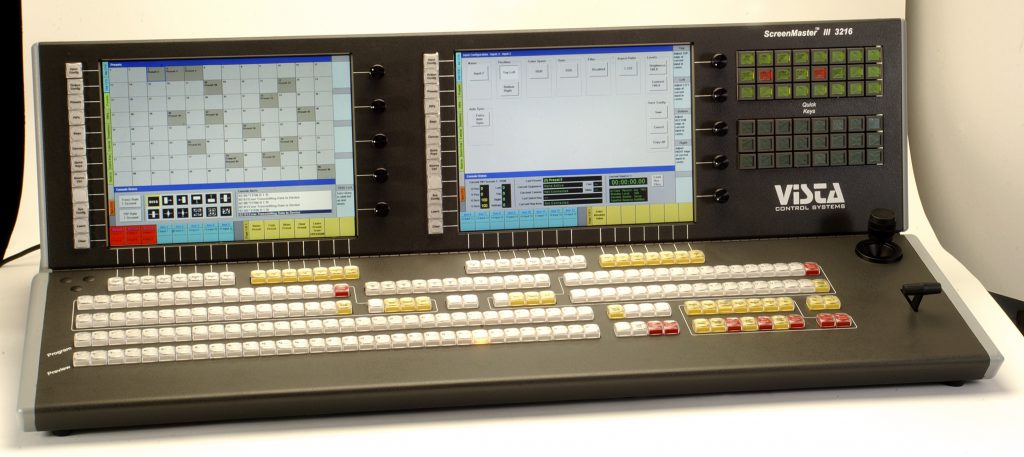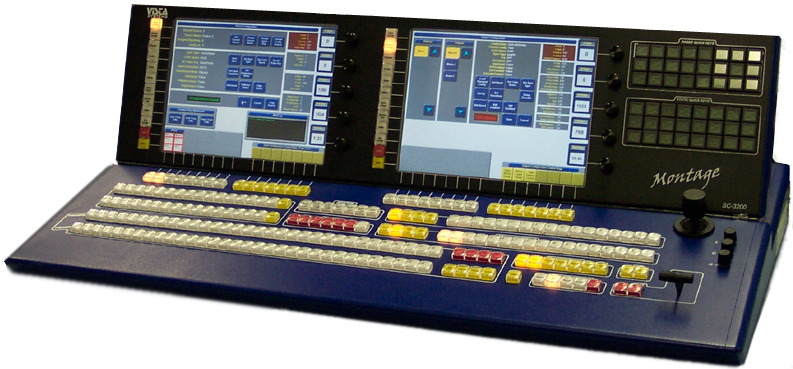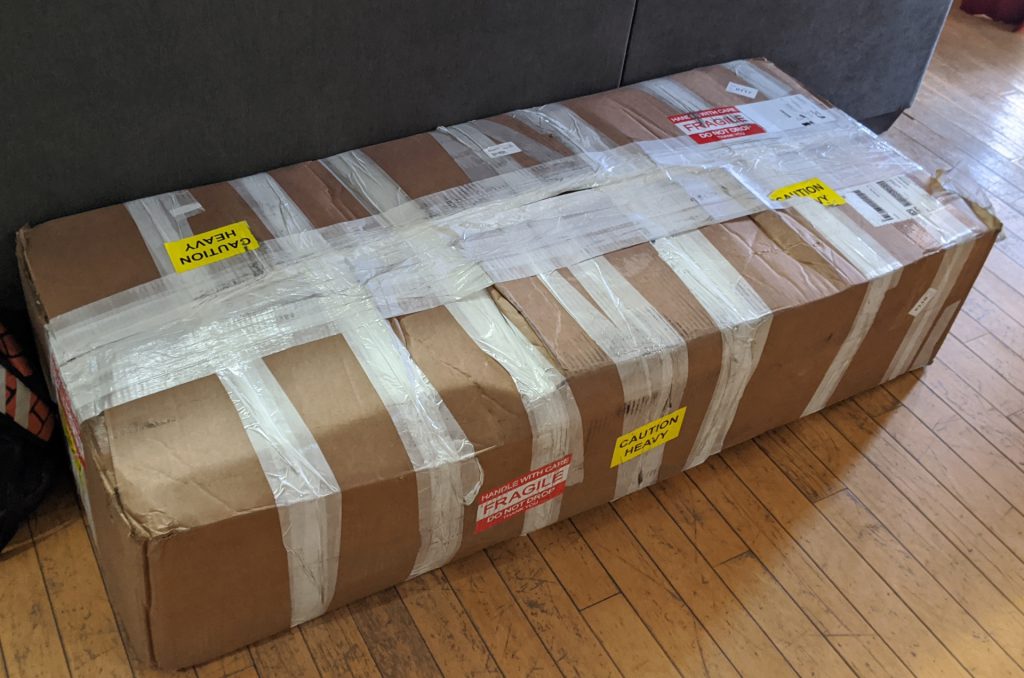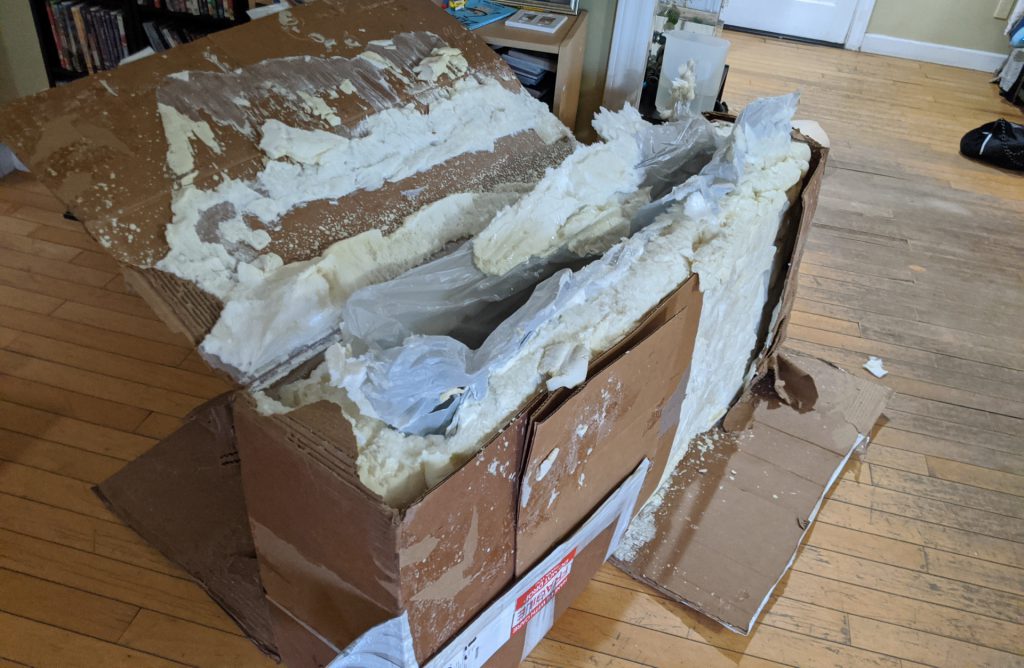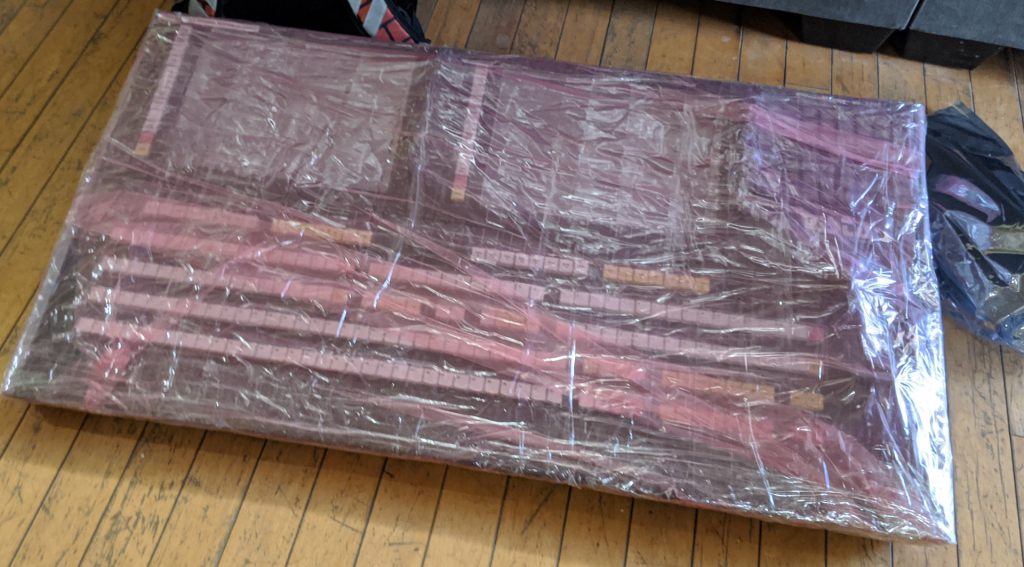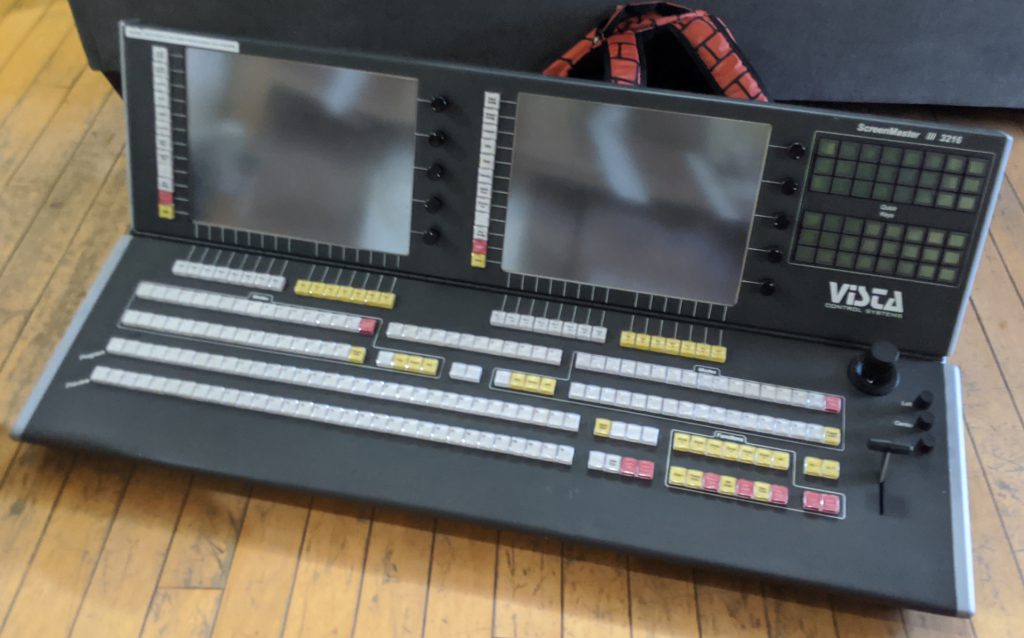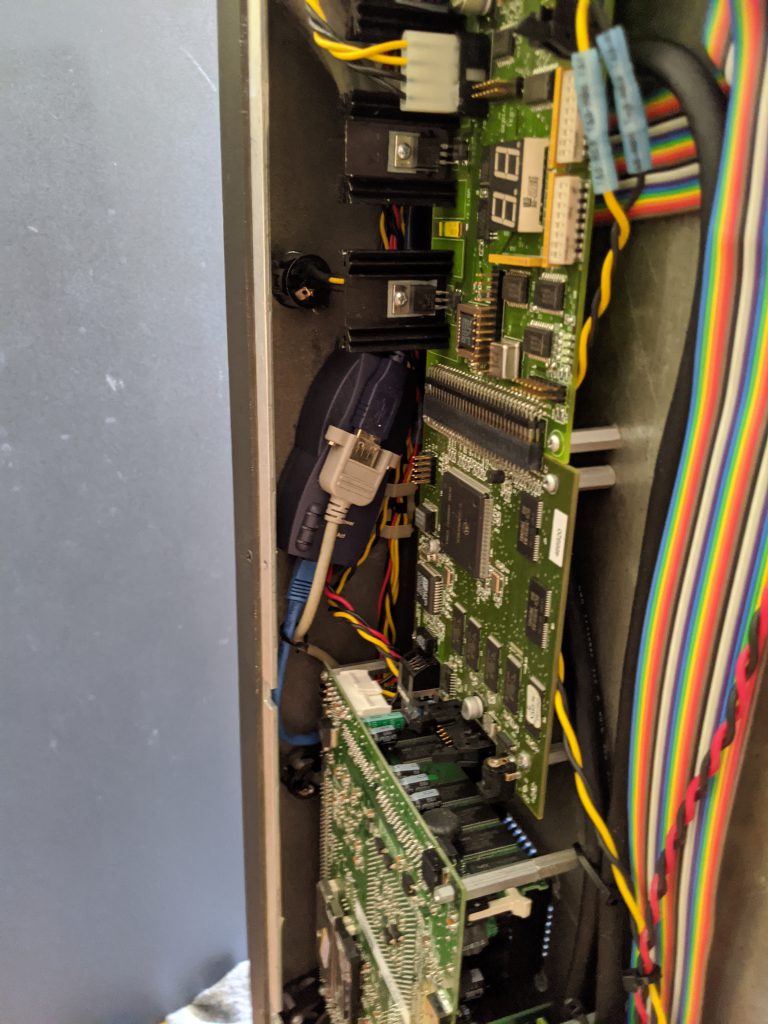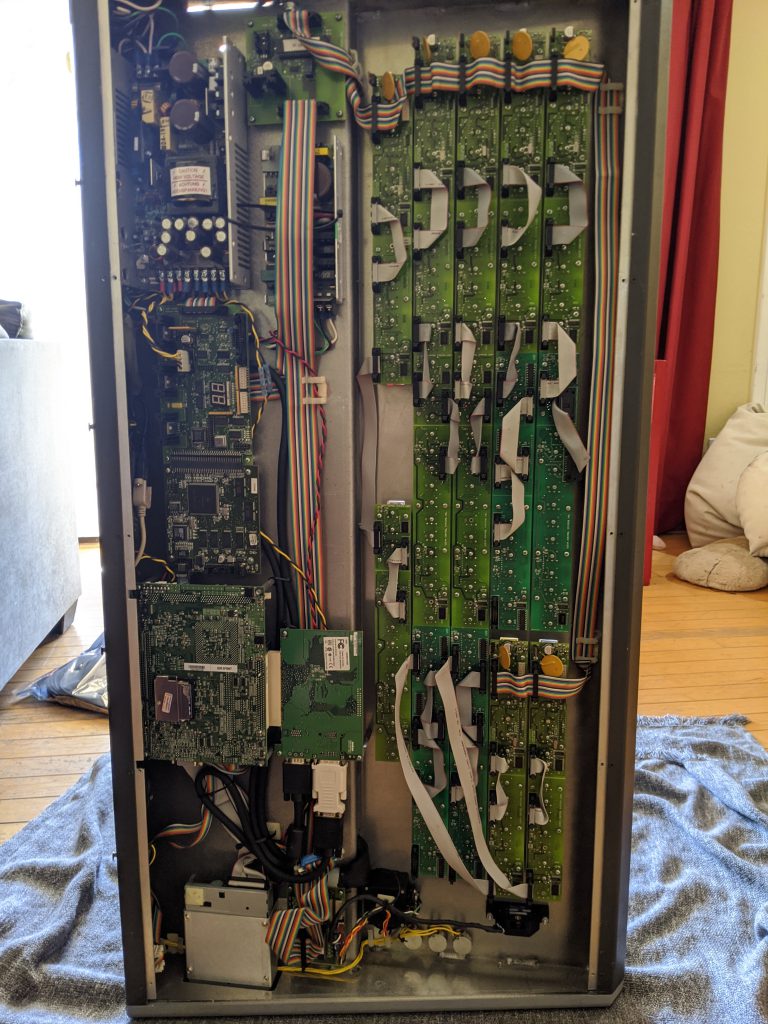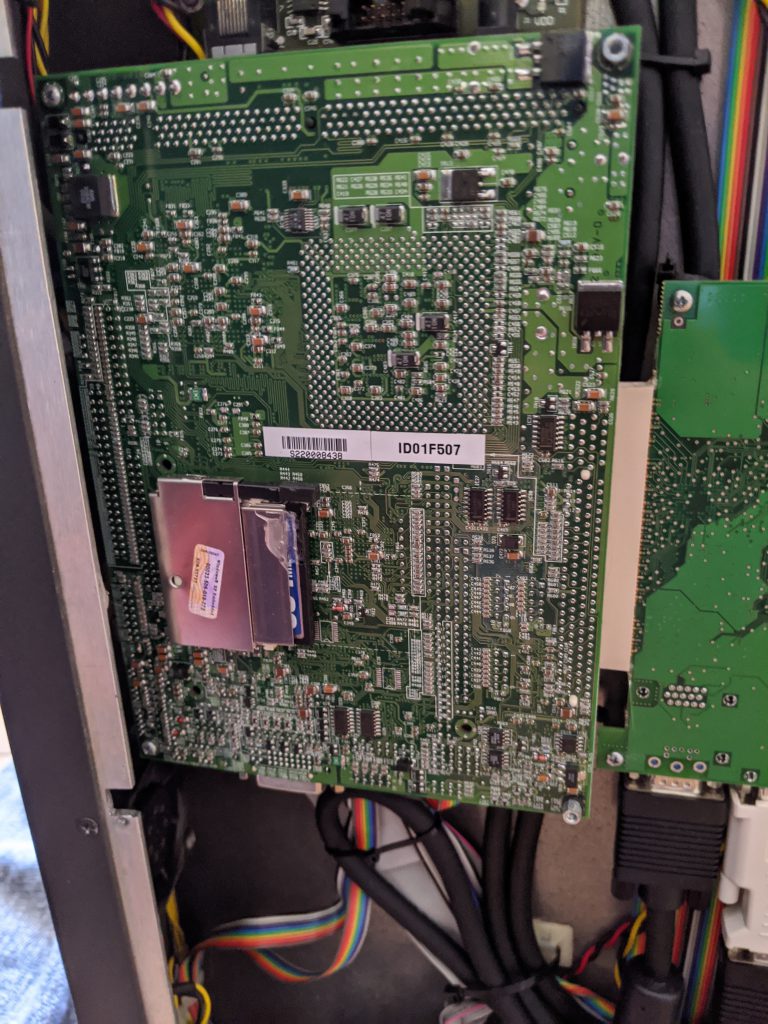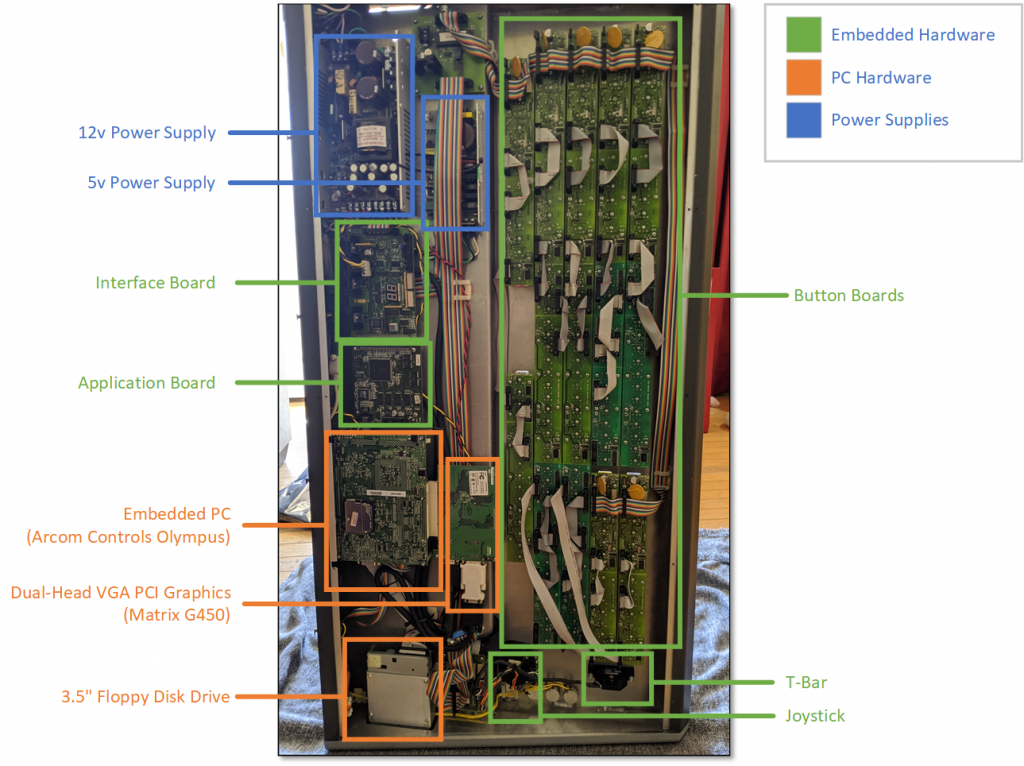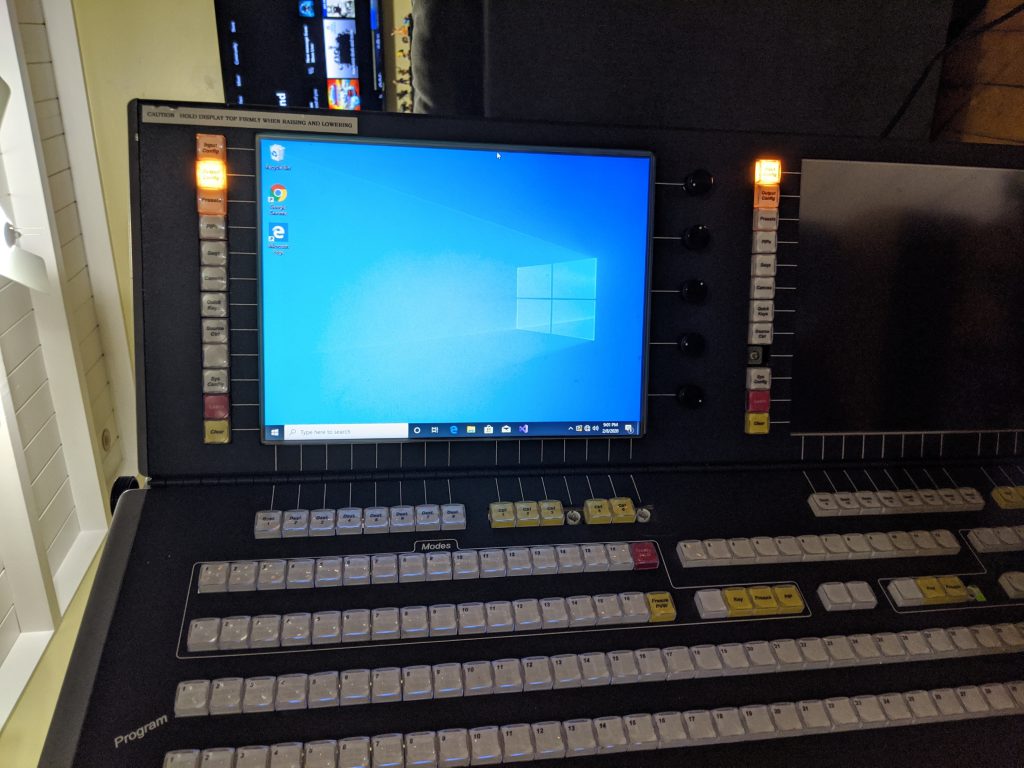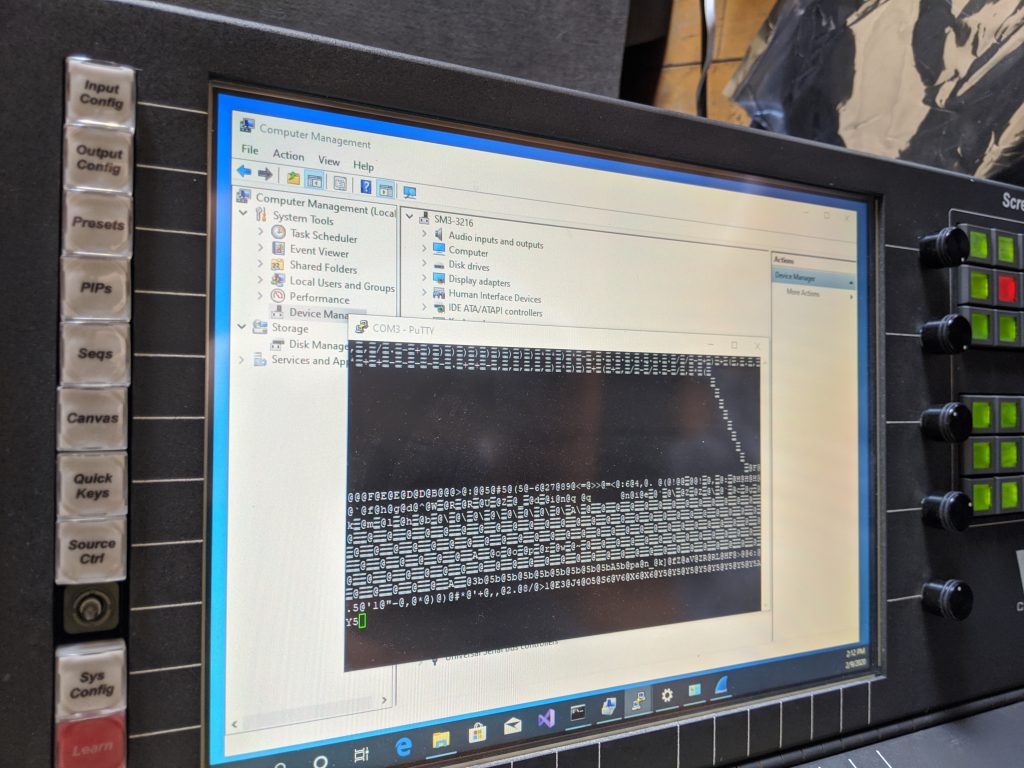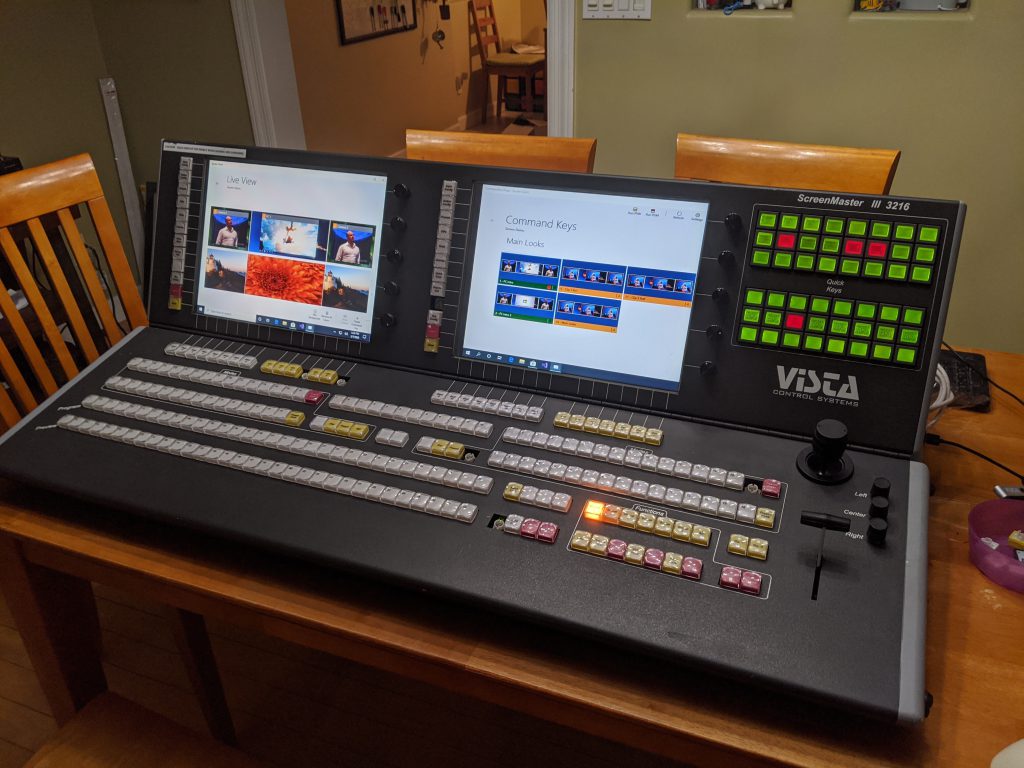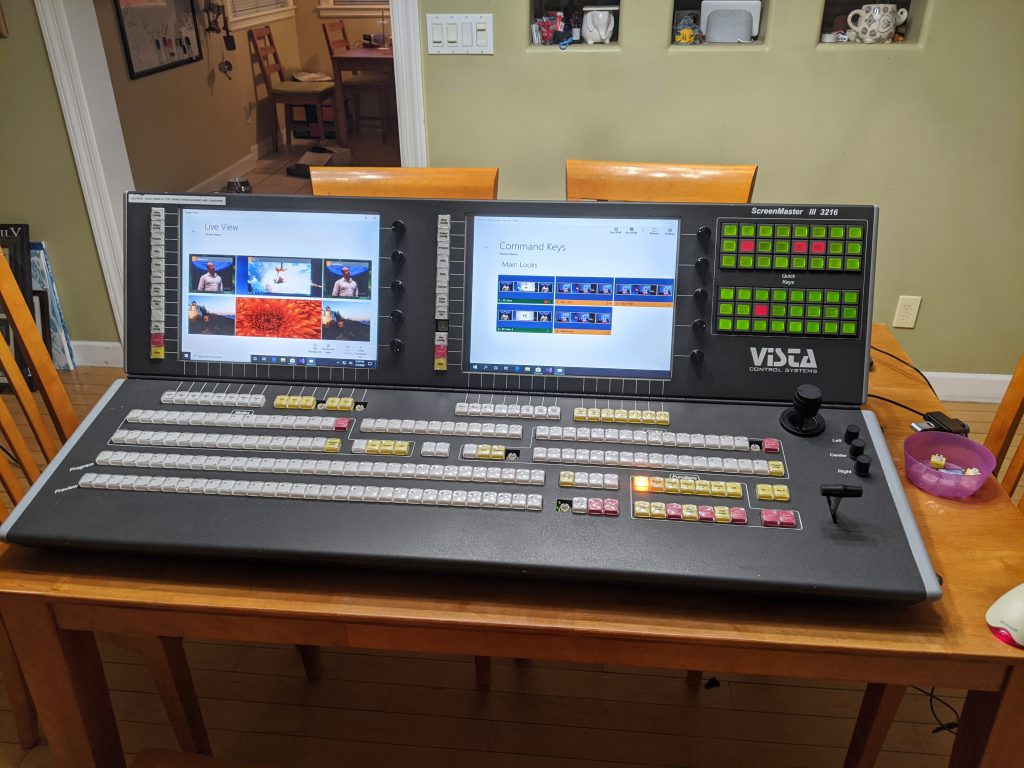The ScreenMaster III 3216 and it’s half-sized little sibling the 1608 were some of my favorite consoles every made at Vista Control Systems (later renamed to Vista Systems and later acquired by Christie Digital). These were the first consoles to incorporate 15″ touch screen displays to compliment the massive button boards from prior console generations. This console, like others before it, were purpose built to control a combination of Folsom (now Barco) VFC-2200 scalers and either Extron, Pesa, or Sierra routing switchers. We’re talking analog video only here – this was the nineties after all, when 1080p video was king.
It’s worth a note that this console would be appear again in the future as the control surface for the Vista Montage video processor, painted in blue and re-dubbed as the Montage SC-3200 console. This stuff is all but lost in time, even on the internet these days, and so I’ve included a picture below for full historic reference.
Let’s talk about this got started
Let’s talk about eBay. eBay is a great place to get great deals, and is a great place to troll late nights when you can’t sleep to find stuff you didn’t know you needed (and probably don’t need). One night I happen to be aimlessly looking around the internet, and somehow I made it to this posting on eBay:
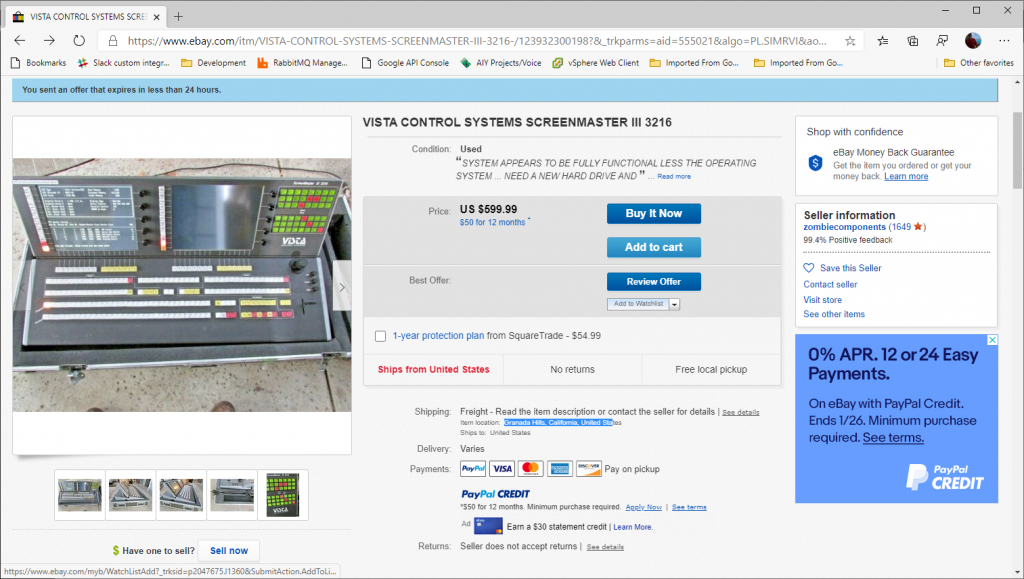
This picture of the console immediately gave me ‘the feels’, as it has solid sentimental value. I remember shipping the first of these consoles, sometime back in the nineties. We had a problem with a driver for an internal USB network adapter, and it was causing the console to bluescreen. We weren’t sure it was fixed, but I ‘thought’ I had resolved the issue with an updated driver. We got the console in it’s case and brought it to the back door. After talking a bit about this bluescreen, Jeff Wilson and I opened the console up and made sure it booted successfully five times. As long as it could boot five times in a row, then we’d ship it. Good news – that was the day unit #1 shipped.
<rant>Just to touch briefly on that last point – this was a time when Windows was considered to be generally unstable, and we caught a lot of flack from rental and staging customers (and competitors). Here we were though, shipping a device with Windows (NT Embedded I vaguely recall) and asking customers to entrust their high-dollar live events on it. Software bugs aside, I think this ask proved to be a reasonable one and these consoles were way ahead of their time (my opinion). </rant>
So this console on eBay had an asking price of $599, and I sent an offer for $299 which was accepted. I don’t remember the real figure, but I think this console cost around $45,000 new. From the pictures I could see some button-board activity and a boot failure, and so I knew that (1) the embedded part of the console was alive and (2) the PC was ‘alive’ and the Compact Flash card we used for the hard drive had likely failed. After some back-and-forth on the shipping, we decided to drop the shipping case to avoid going freight, and all-in I think I was down $500.
The arrival
It took about a week for my console to arrive, and it showed up packed tight with instant-foam in a box that must have had a roll of fiber tape for additional support. It took a solid hour to practically chisel the console out of this foam tomb, but it shipped in pristine condition so I can’t complain.
After getting the console freed from it’s shipping cocoon, I gave it a good look over and powered it up. The screen showed the same hard drive failure message that I saw on the eBay post. The quick-keys (the top-right green button array) showed diagnostic counters that I was able to use to verify that the buttons, joystick, T-bar, and rotary encoders were all functional (minus a few burnt-out incandescent switch lamps). So far so good. Next up is to take inventory of the computer hardware and try to get it working again, but before we move on go ahead and take a hard look at that good-looking piece of hardware 🙂 .
Console internals
When you open the bottom of this console, you immediately see that there is a LOT going on. Luckily, when we look closely at the internals of the console there are two main subsystems – the embedded computer (PC) and the physical control interface (buttons / T-Bar / Joystick) subsystem. The picture below shows the console on it’s side with the bottom removed.
The application board is the main embedded component which houses the programming required to read and write the physical hardware. Luckily for us, the interface between the embedded computer and this application board is Ethernet. It’s difficult to see in the pictures, but there is an Ethernet crossover cable between a second Ethernet port on the SBC and the application board. This is great, because it means that we can upgrade the embedded computer without worrying about obscure hardware interface dependencies.
Before we move on to replacing the embedding computer, let’s take a second to talk about the embedded computer that came with the console. This was an EBX form factor computer called the ‘Olympus’ and was manufactured by Arcom Controls (datasheet here). This was a 1.0 Ghz Celeron processor and 128MB of RAM. The hard drive was provided with a 128MB Compact Flash card, which has limited read/write cycles and almost certainly explains why the console eventually stopped working. I did try jump-starting the console with a new Compact Flash module, but the SBC was so old that it felt that even if I could run a modern operating system on it (unlikely) that it would be terribly slow. It was also sporting a 3.5″ floppy disk drive, for those of you who remember what that even is, and I knew that needed to be brought into the modern age as well. With that back-story out of the way, let’s get to upgrading.
Upgrading the Embedded Computer Hardware
Full disclosure here – this console sat on it’s side in my living room for several weeks, and I’d give it occasional blocks of evening and weekend time. This wasn’t particularly hard, but there were some time-consuming parts of the effort that I’ll bullet point rather than writing a book about:
- Removed the prior EBX form-factor PC board and graphics adapter
- Removed the existing floppy disk drive
- Drilled holes in the chassis to fit a new Mini-ITX form factor PC
- Bought a +12V to ATX power adapter module to power the new SBC
- Added two USB to RS-232 cables to drive the touch screens
- Added a USB to Analog adapter to drive the second touch screen (the SBC had one VGA port I was able to use as well)
- Replaced the Neutrik Ethernet connector running to the back of the console with a new one
- Modeled and 3D Printed a custom bracket to hold a new Solid State hard disk and expose 2x USB 3.0 ports to fit in the old floppy disk drive spot.
The mounting and retro-fitting of the new SBC and parts was a pain, but I’m pretty happy with how it came out. This thing feels like it could travel and be as reliable as the original console was. I am particularly proud of the 3D printed module that I made to hold the hard drive and expose a couple USB ports, and you can see this along with a bunch of other build pictures below
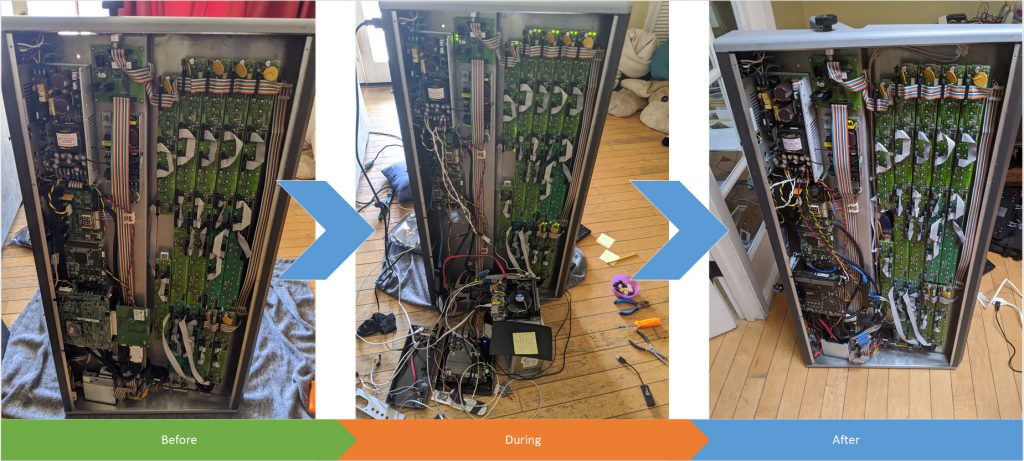
Before/During/After 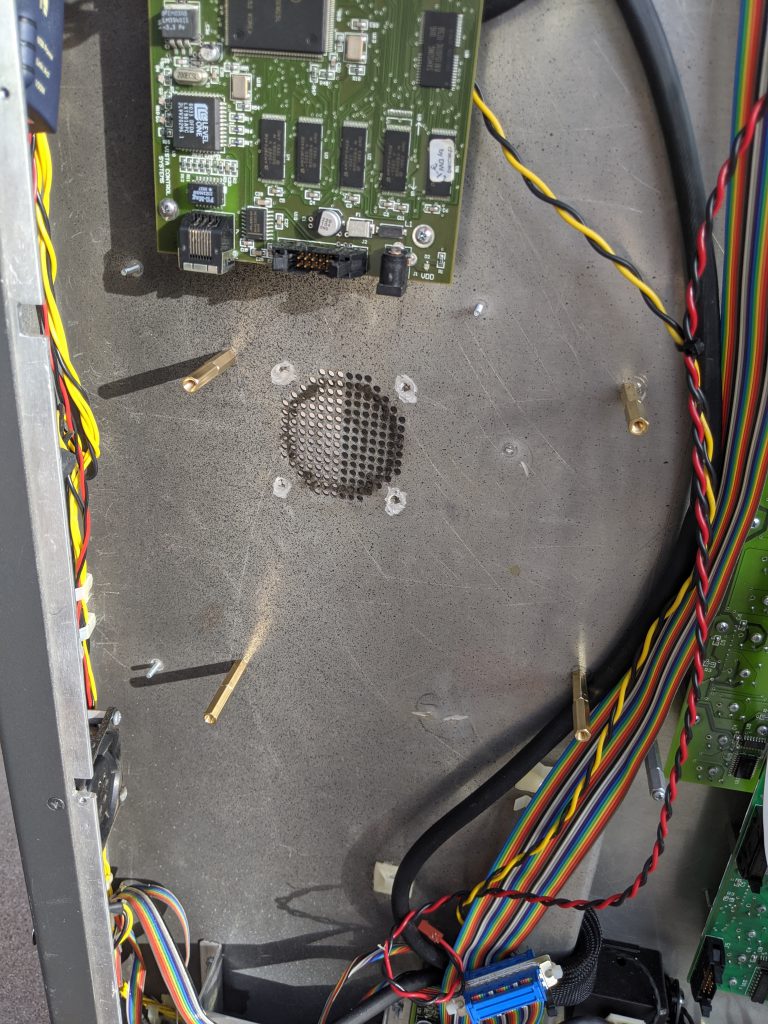
After removing old SBC 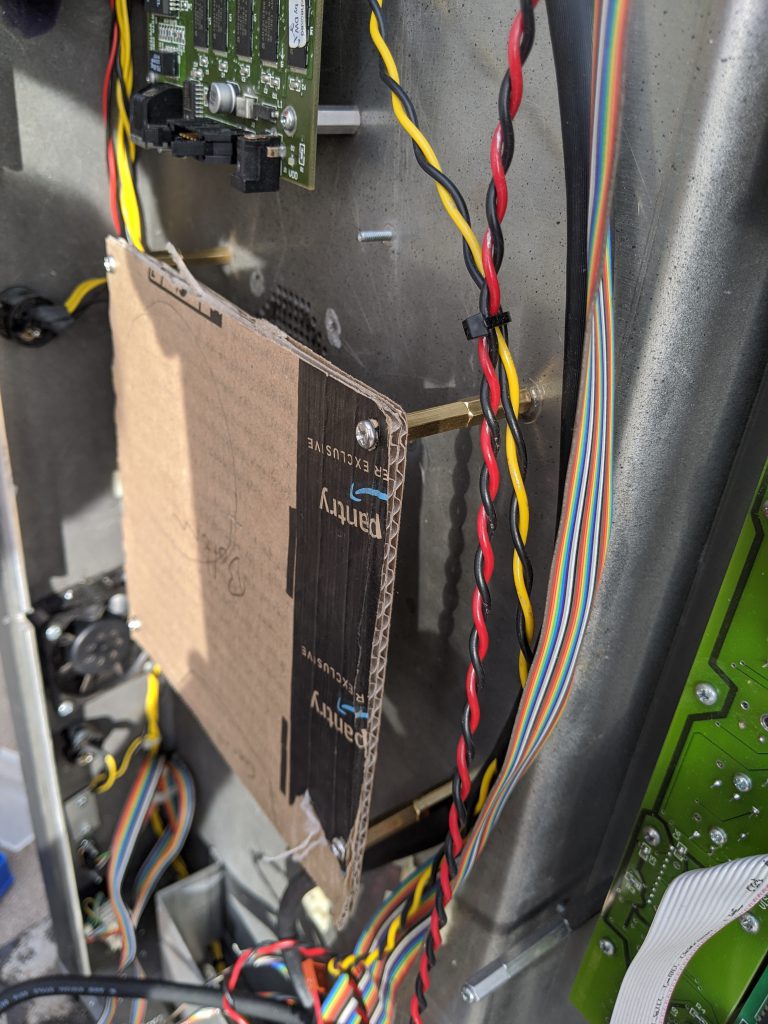
Installing new standoffs for mini-ITX form factor 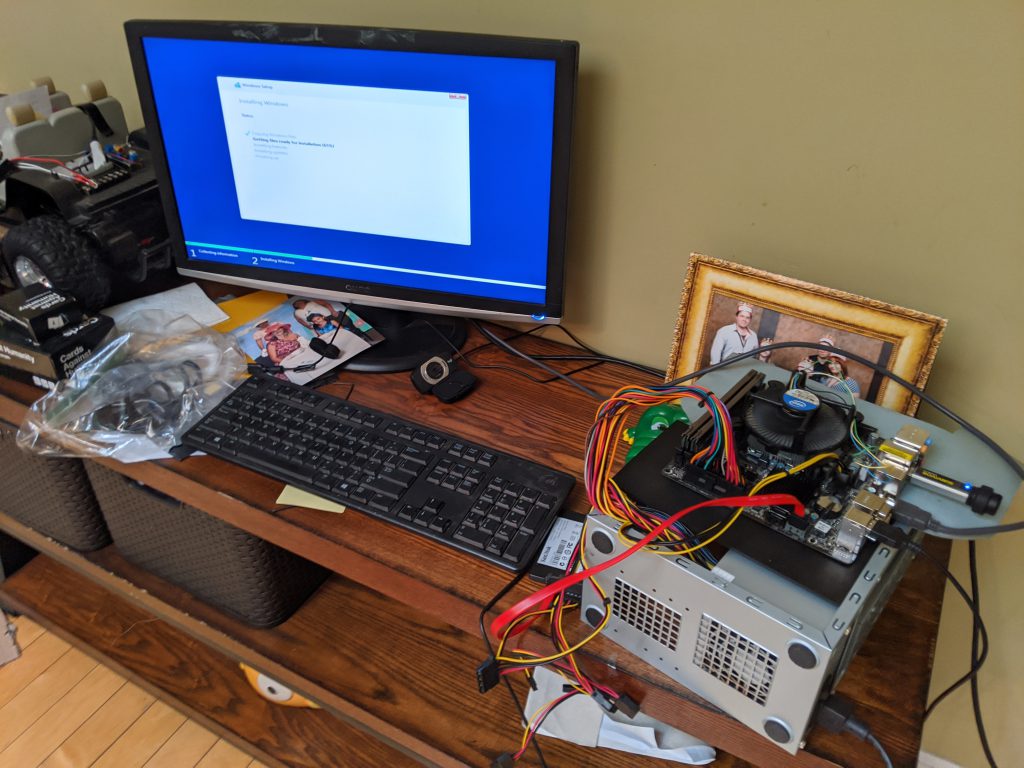
Getting initial Windows image and testing new SBC 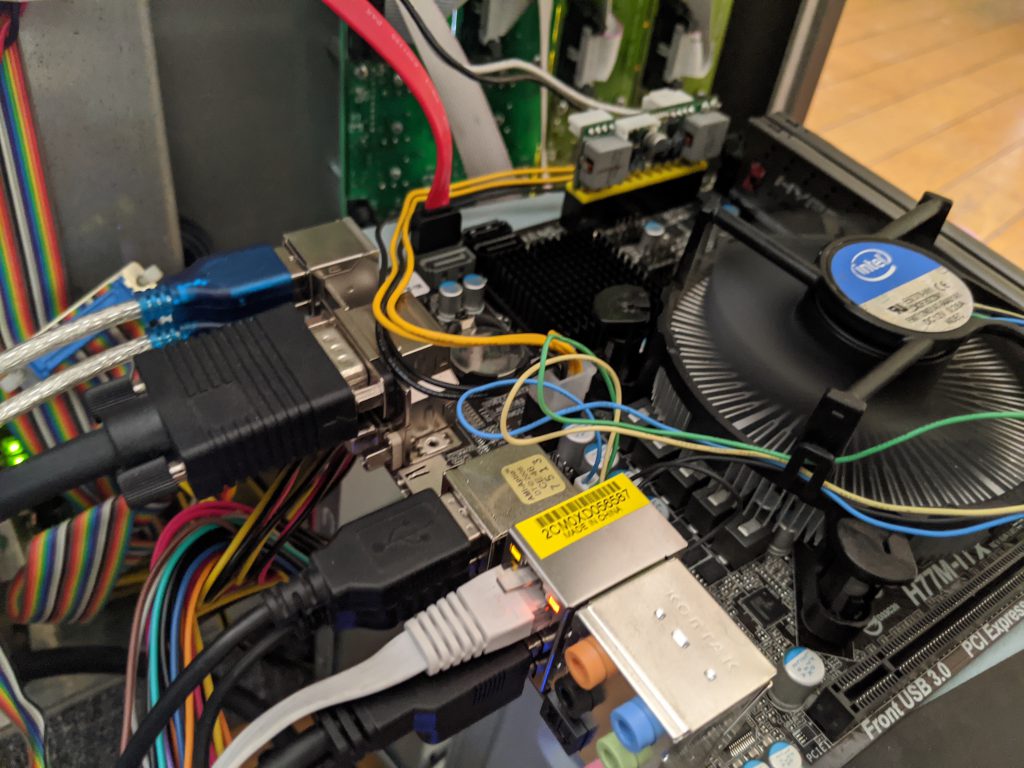
Getting connections together for SBC 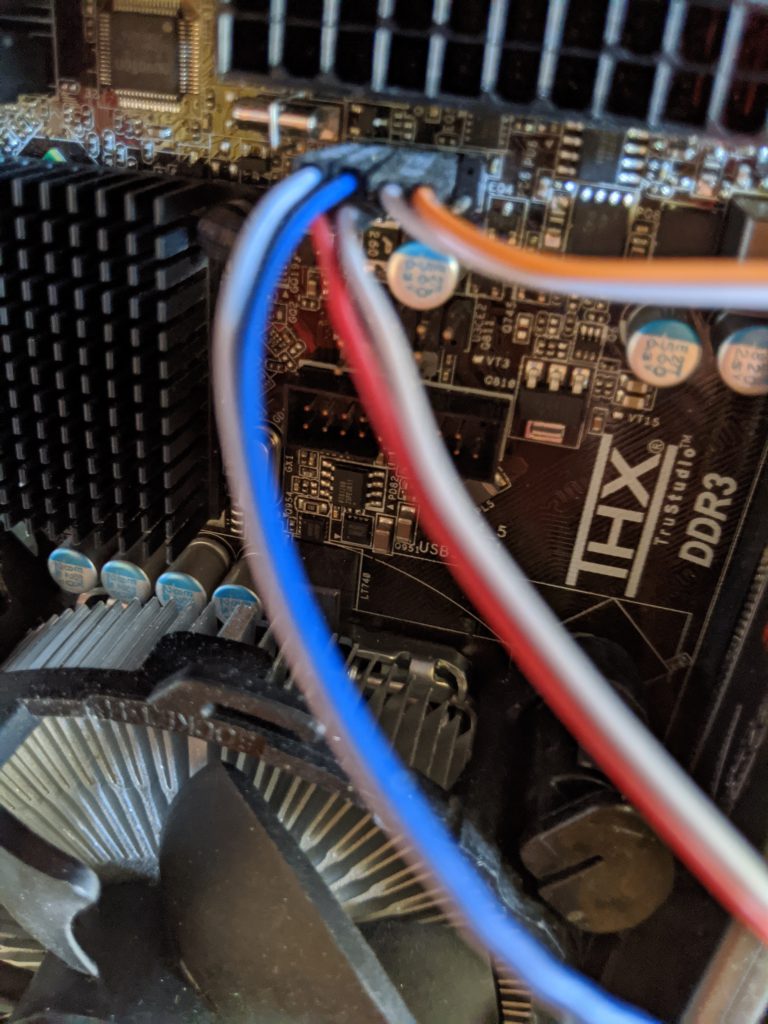
Wiring motherboard headers 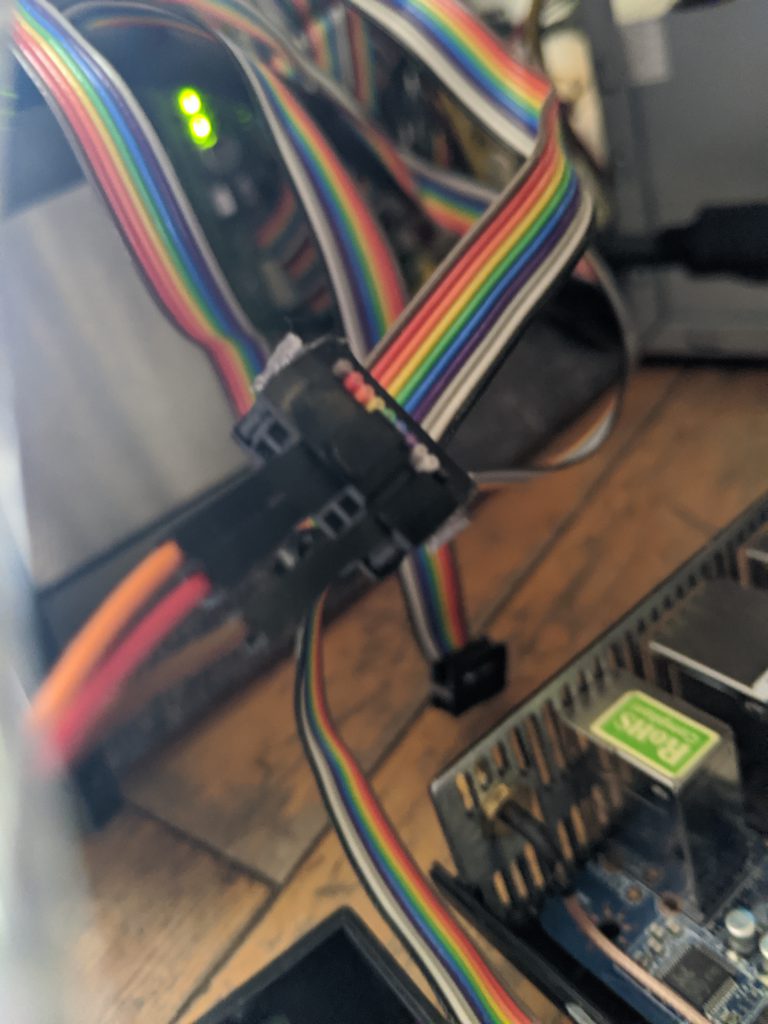
Adapting serial connectors from old 10-pin headers 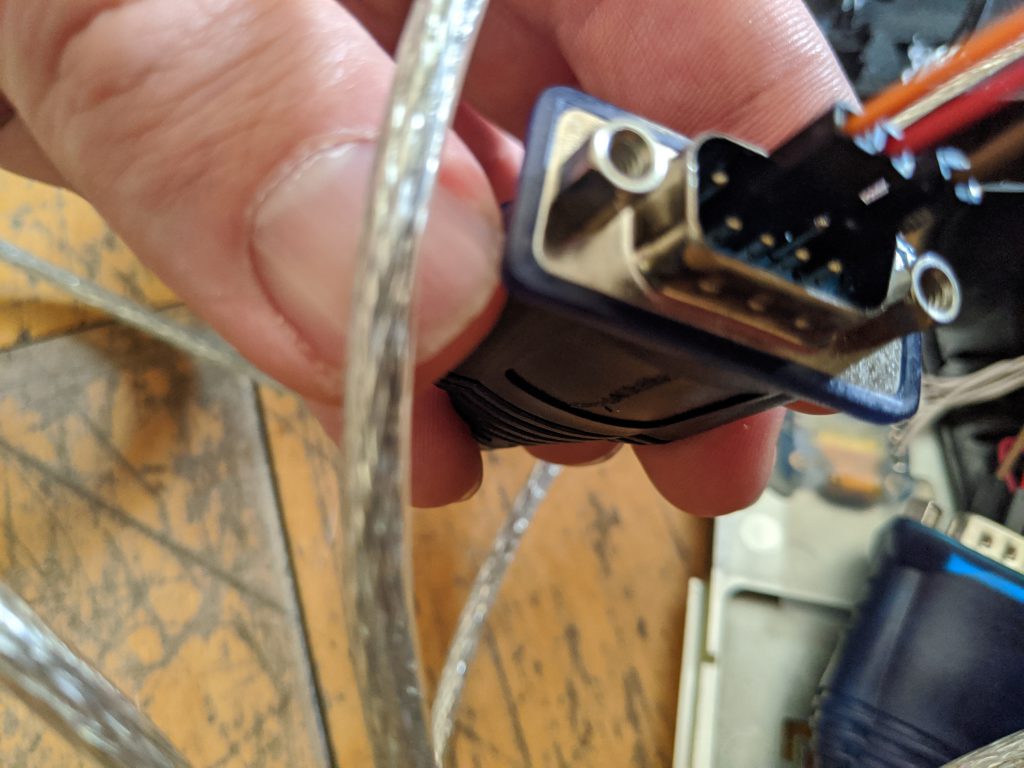
Adapting serial connectors to RS-232 USB adapter pins 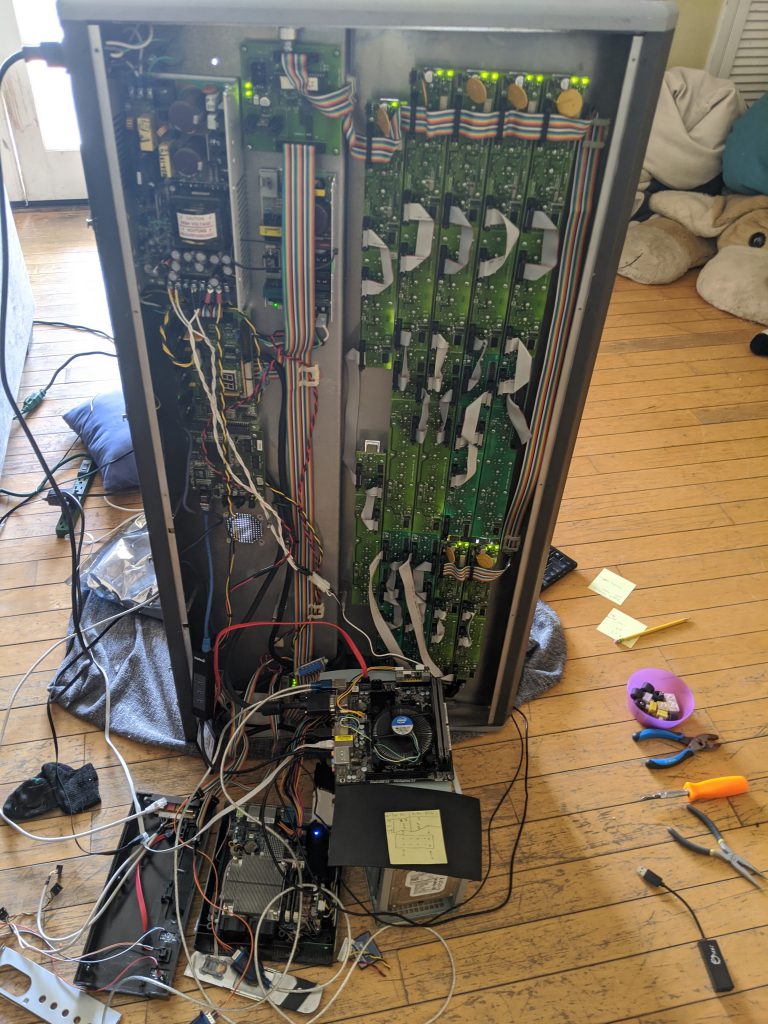
All hardware connected loose to ensure stuff works 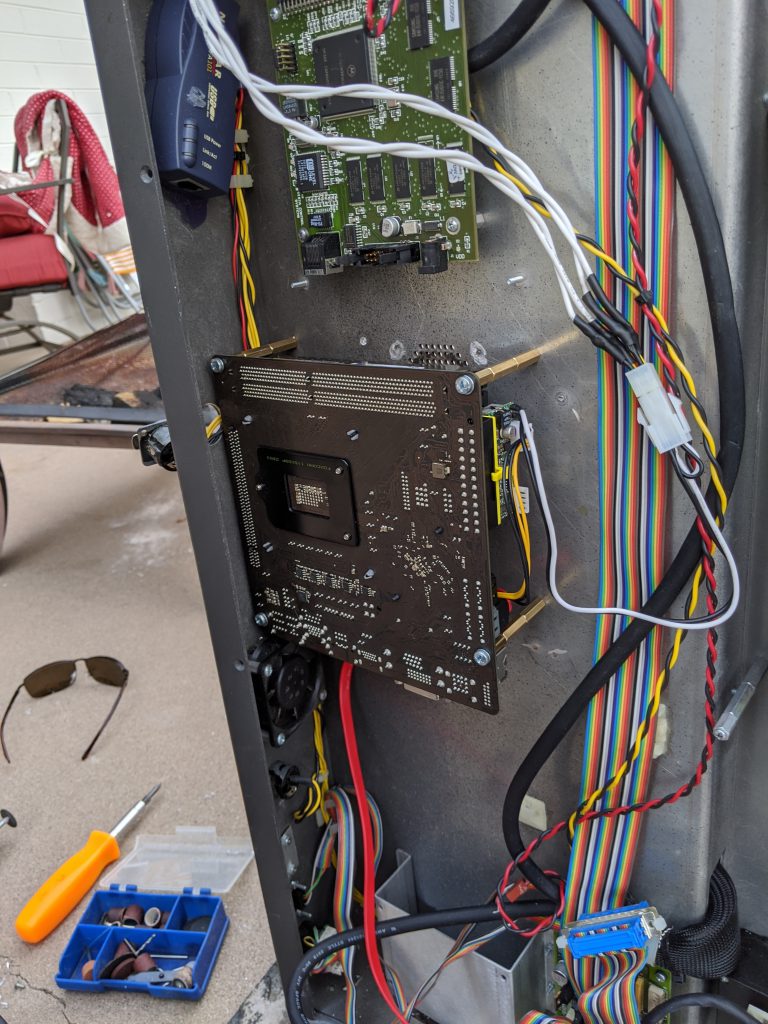
New SBC mounted in place 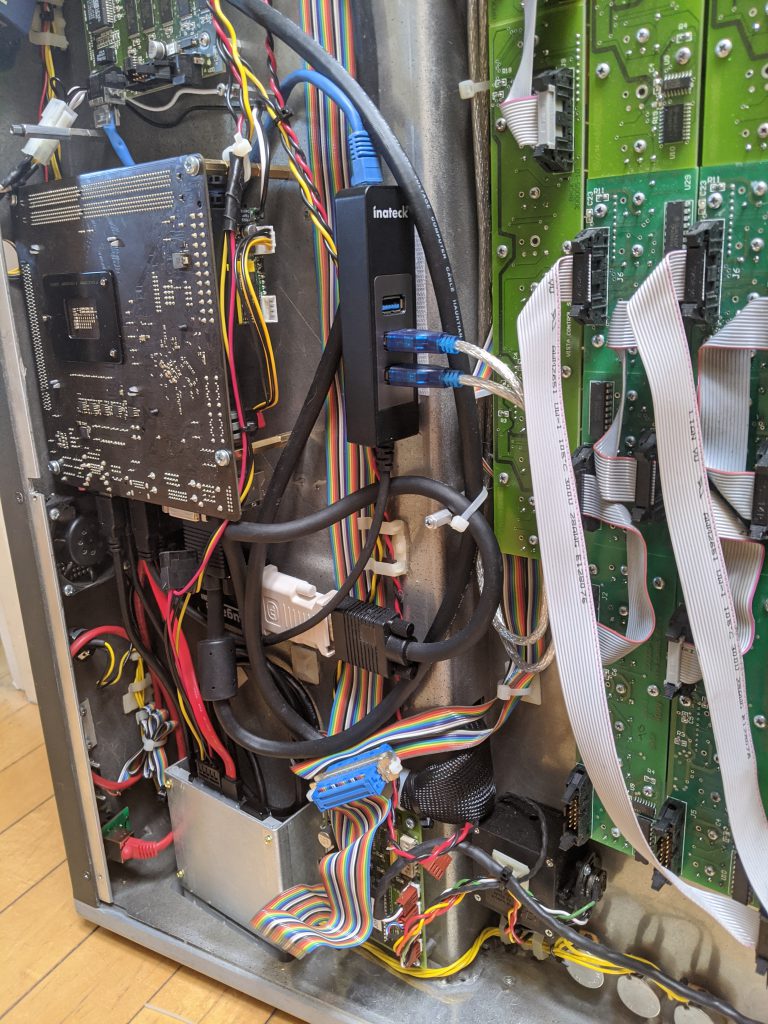
Connections made to SBC 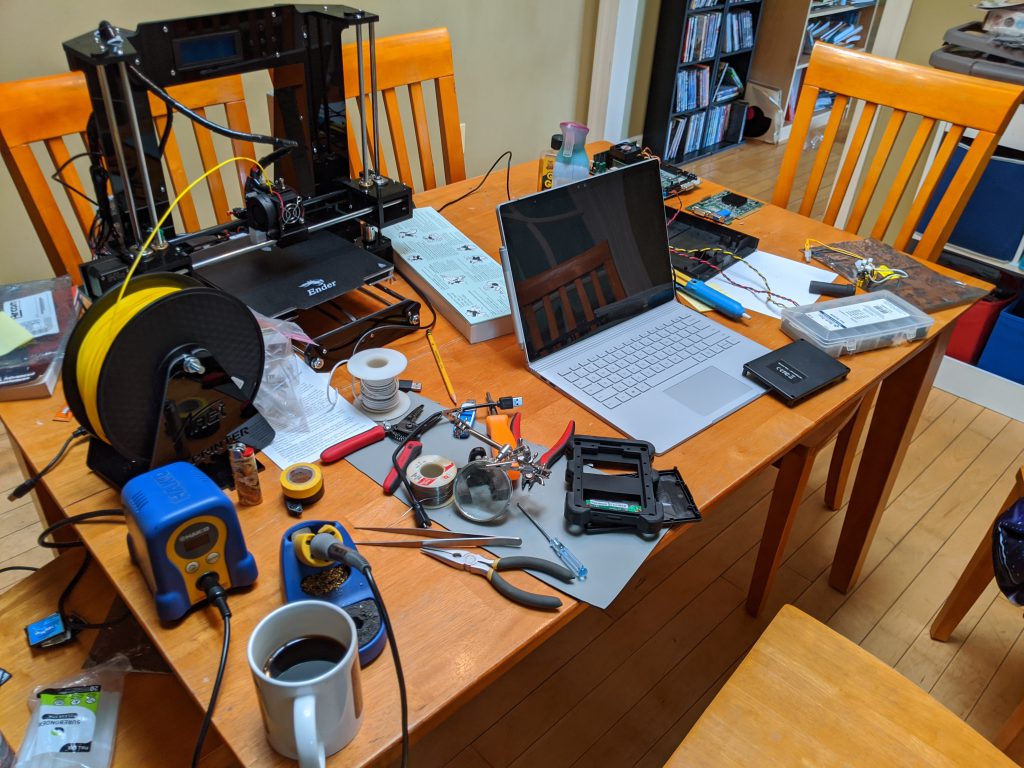
Workstation / Kitchen table area for 3D Printing and wiring 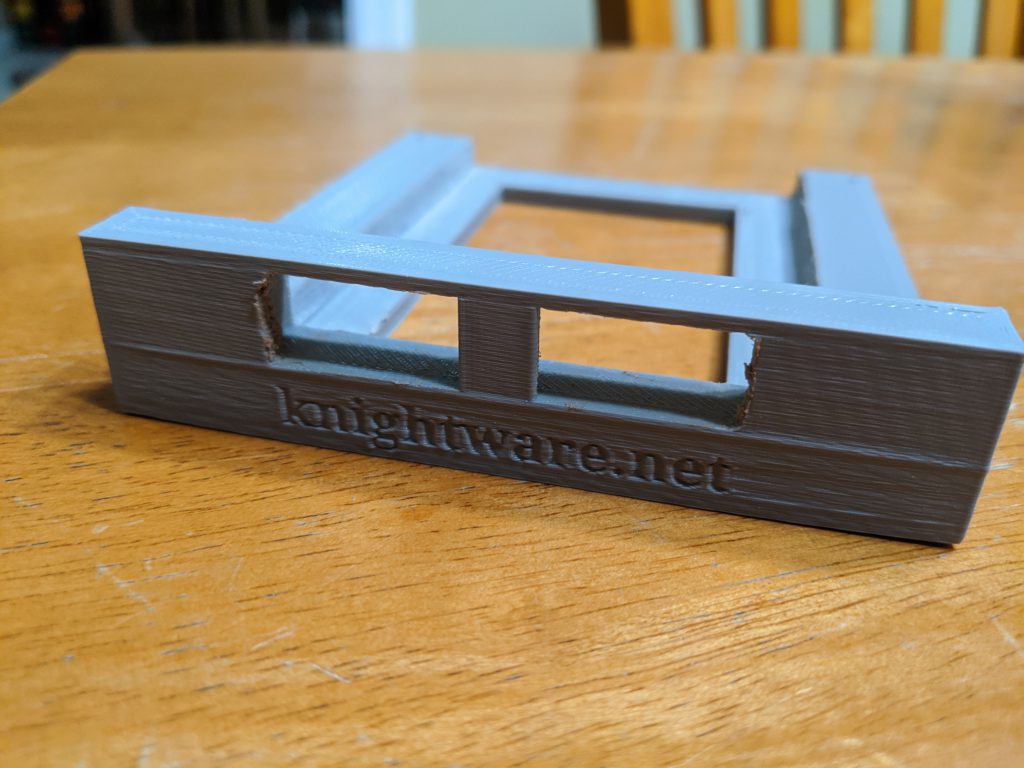
New chassis bracket to hold SSD and USB 3.0 connectors 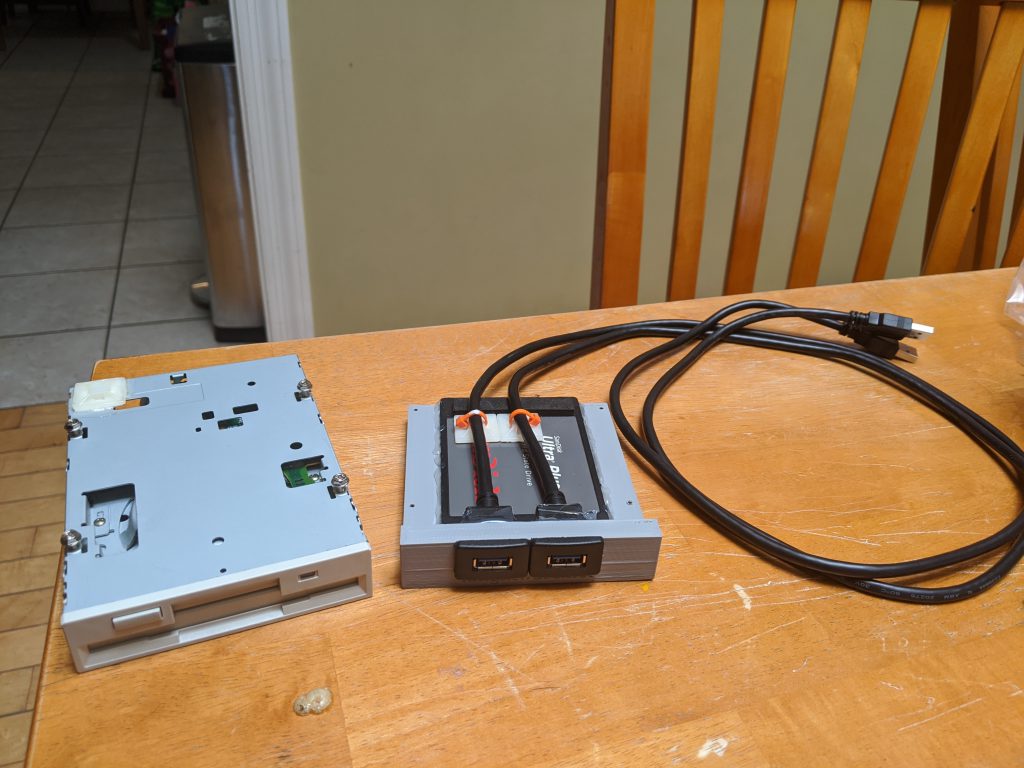
Old disk drive vs new bracket 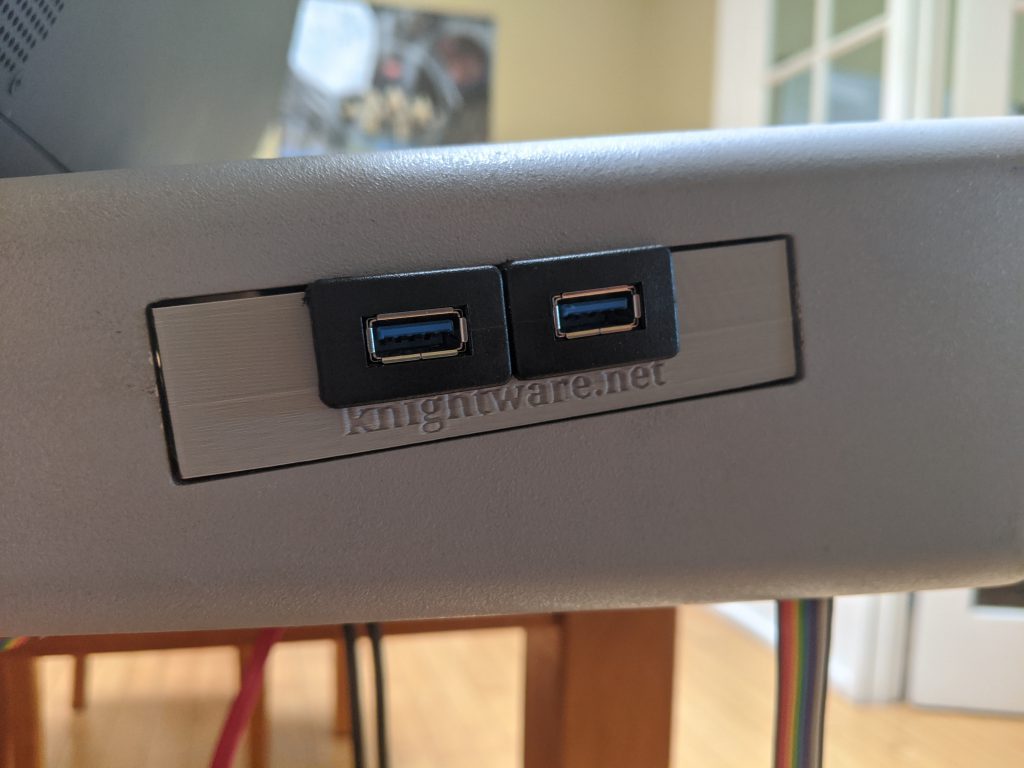
Completed bracket installed in console 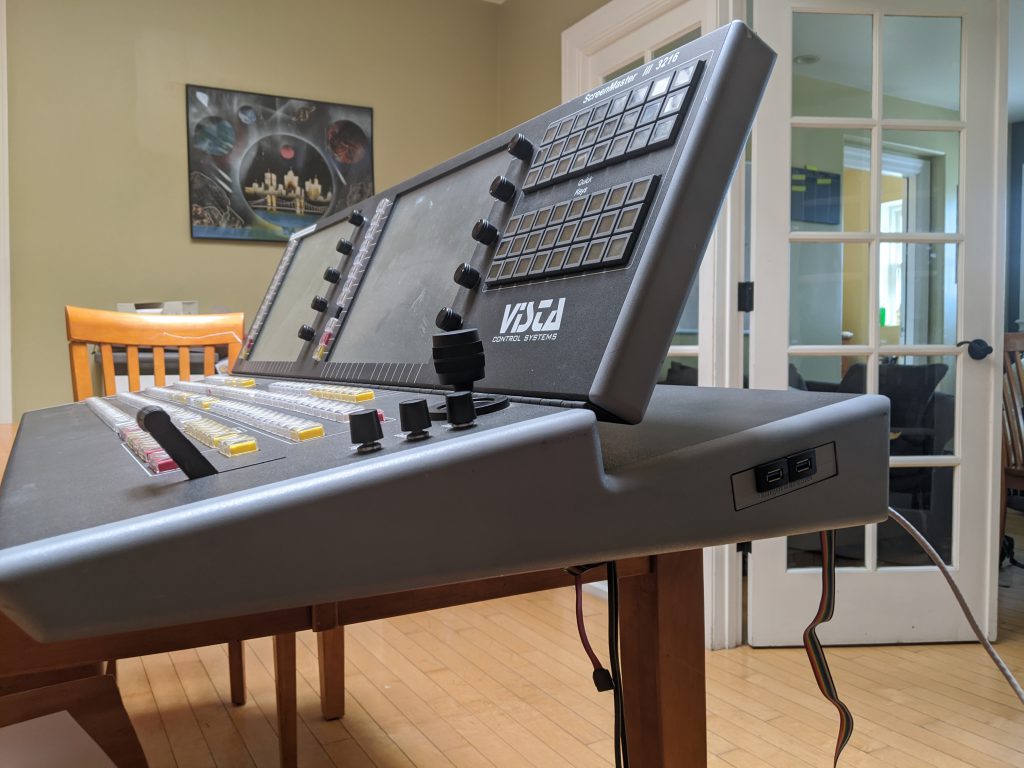
Console done with drive replacement bracket 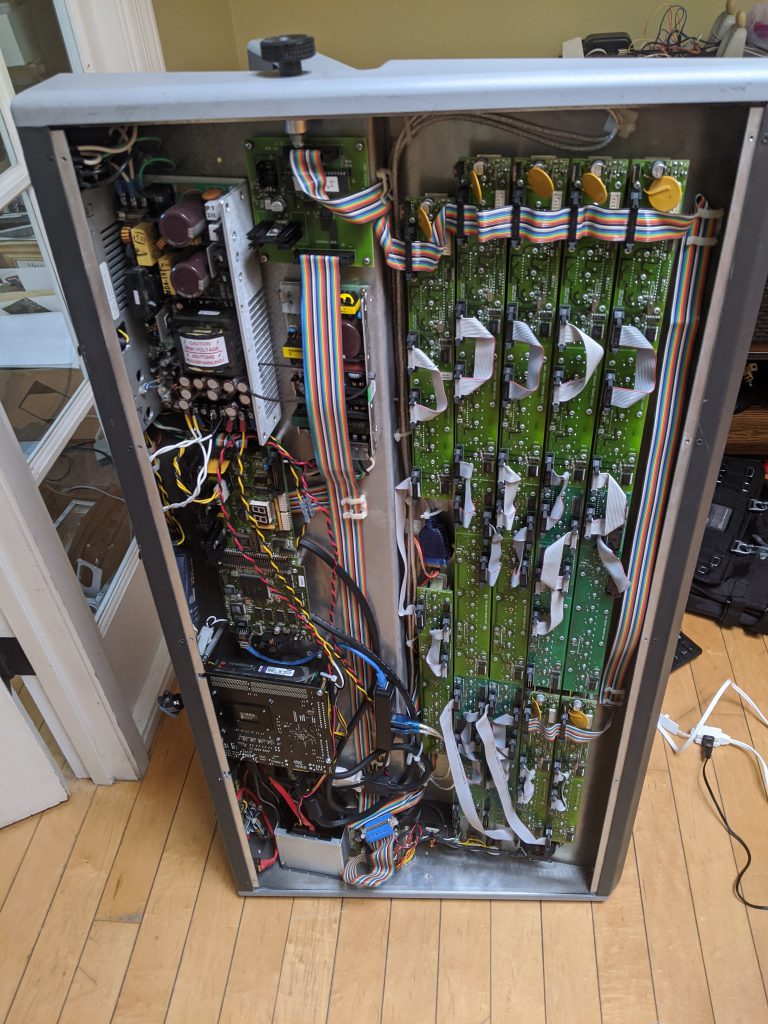
All parts installed and ready 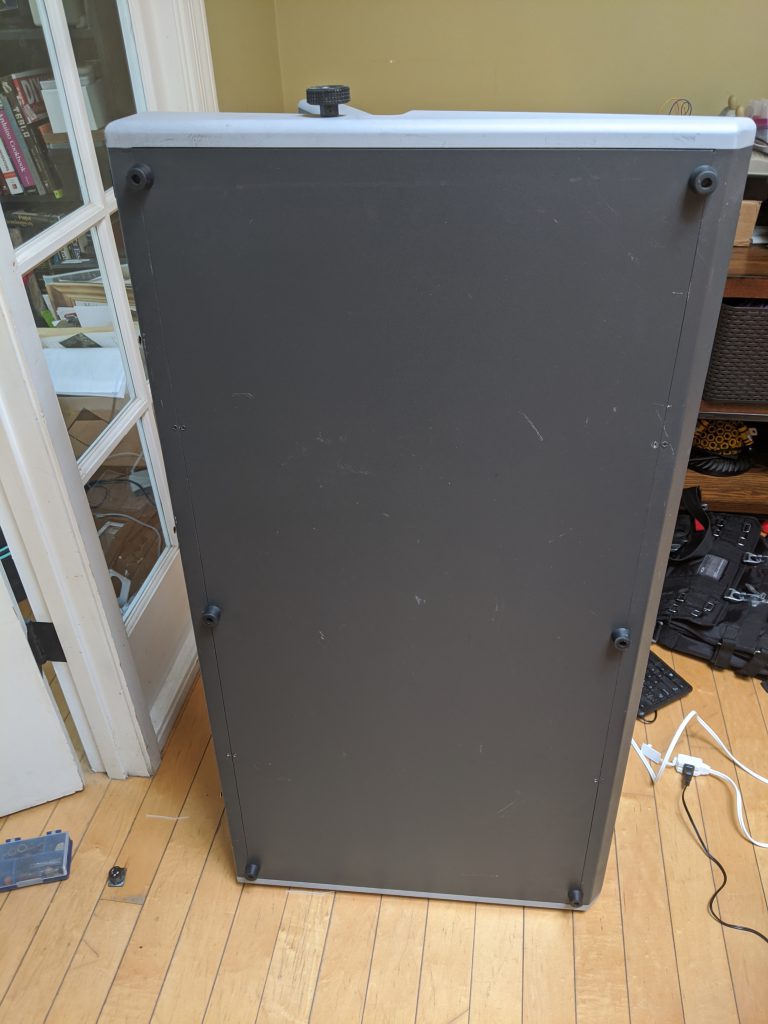
Bottom back on and everything fits!
After the aforementioned evenings and weekends spanning may weeks, the hardware for the console was done. It was now sporting an Intel i7 processor with 16GB RAM and a 512GB solid state disk, and was running quite nicely. I did sneak in a picture of installing Windows on the replacement Embedded PC / Single Board Computer (SBC), but I’ve saved this for the last section of this post.
Let’s put Windows 10 on this thing
A modern console needs a modern operating system. I actually considered installing Ubuntu Linux for the fun factor, however ultimately I decided to install Windows 10 Pro. It’s less ’embedded’, but it allows for wider flexibility for software to run (including Vista Advanced / Spyder Studio / Spyder Client software).
One wrinkle that I did run into was around the touch screens. They have RS-232 serial controllers, and the native 3M driver didn’t work. I remember running into this with my Car computer touch screen (same hardware), and so I knew I needed to pony up and buy a license for a software called touch-base that makes the touch controllers work with Windows 10. Related note – the screens for the console are each 1024×768 resolution and VGA, and if I were braver I would crack open the top and try to replace them with some newer displays. Maybe someday.
Big reveal time
I don’t need a lot of words for this – I’ll let the pictures of the console working speak for themselves. For those curious, the pretty looking Spyder control software is the Spyder Client application that is available on the Windows 8/10 Store.
So where are we, and what’s next?
So we have a large powerful hardware console alive and well, and we have a working PC operating system on it. Probably a way over-powered PC in there hardware spec-wise, but we still don’t know what we’ll do with it so hard to say. By the time I write this, the console has actually been sitting in my dining room for the past two months. I’ve already done some development and created a software interface to integrate the hardware with the PC, but I’ll save that for a future blog post.
In the next post, I’ll talk about how the PC-to-embedded hardware interface works, and we’ll probably have a simple app to show take a look at. I expect the next post will be a bit shorter – this one was a monster and it feels like it just skims the surface. With that, thank you for reading and see you next time!
